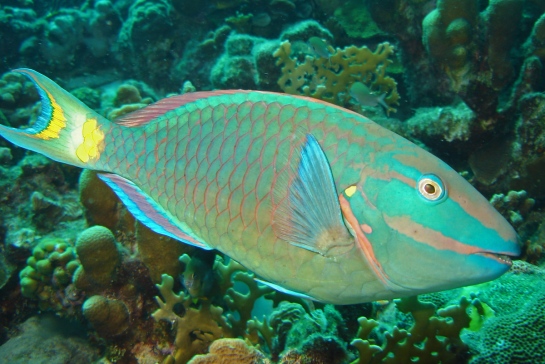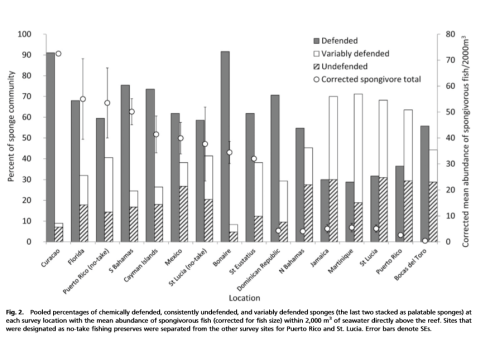21
Parrotfish are colorful fish found throughout the world’s coral reefs. There are about 90 species of parrotfish, including Stoplight, Queen, and Princess Parrotfish common in tropical and subtropical parts of the western Atlantic Ocean and the Caribbean Sea. Parrotfish are characterized by a beak-like structure (fused teeth) that they use to feed. They are mostly herbivores and feed on algae, but also feed on corals and sponges. Their beak helps them scrape algae and crush the hard limestone of corals. They then excrete this undigested material as sand, which helps to create the white sandy beaches of the tropics.
Parrotfish are also known as sequential hermaphrodites. A sequential hermaphrodite is an animal that goes through an initial and terminal phase during its adult life. Each phase is characterized by being one gender. So, for example, some species of parrotfish start as female in their initial phase, then change to male in the terminal phase. This change usually takes place due to an environmental cue, such as the loss of the dominant male.

Probably the most interesting thing though about parrotfish is their role in coral reefs. Coral reefs face a number of stressors including ocean acidification, rising ocean temperatures, and changing ecosystem balance due to overfishing and bycatch. Interestingly, studies show that the number one thing we can do to protect the health of coral reefs is to limit the number of parrotfish we remove from the environment. In the Caribbean, parrotfishes are the primary herbivores on the reef at mid-depth, helping keep macroalgae in check. A shift to macroalgae dominated habitat would offer little value to fisheries, as most of the nutrients are lost to detrital pathways. Unfortunately, parrotfish are commonly fished in the Caribbean. A recent study suggests that if we implement a capture size restriction of less than 30cm there is a win: win outcome in the short term. This would have both ecological and economic benefits as it would also lead to an increase in coral reef health and production. Focusing on more long term benefits requires a more strict harvest limitation to combat the ever-increasing threats to coral reefs.
Parrotfish are also one of the primary grazers of sponges. Sponges (along with corals) are the primary habitat-forming organism on Caribbean reefs. Loh and Pawlik found that parrotfish, along with other spongivores, would graze on sponges that lacked chemical defenses over sponges that possess secondary metabolites. Due to this grazing, the palatable sponges tend to heal and grow faster, as well as have a higher rate of recruitment and reproduction. This allows them to compete with sponges that are left relatively untouched. They also determined that sponge species composition depended more on the abundance of spongivores instead of geographic location. A decrease in the number of these species would result in a top-down effect, leaving more of the faster spreading palatable sponges to out-compete the slower defended sponges and reef-building corals, worsening the state of these coral reef communities. Below is a figure from this paper which compares different sites and the percent of sponge communities and how it relates to an abundance of spongivores.

Figure 2 from the Loh and Pawlik paper
The information in this chapter is thanks to content contributions from William Trautman
